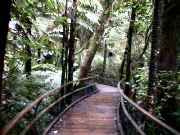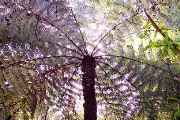Puketi Kauri Forest
|
Manginangina Scenic Reserve.
Around 50,000 visitors annually use the elevated wooden walkway which protects the kauris' sensitive feeding roots, yet allows visitors to get 'up close' to the ancient trees of the Puketi Forest. |
 |
| One of Northland's few wheelchair accessible forest walks, the boardwalk was originally erected in the mid 1990's and was due for some repair. The upgrades, which include replacing non-skid surface on the wooden walkway, are part of the Dept of Conservation's ongoing programme of structure renovation and repair. |
 |
|
Kauri forests contain an abundance of life including other large trees like Taraire, Kohekohe, Towai and Northern Rata. They also are vitally important refuges for threatened wildlife such as Kokako, North Island Brown Kiwi, Kukupa (NZ pigeon), and the more common Fantail, Pied Tit, Tui, Grey Warbler, Shining Cuckoo, and Kingfisher.
|
You can reach Puketi Forest by following the signs off State Highway 1.
There is a camping ground and 24-bunk trampers hut available for public use (bookings essential) which serve as an ideal base from which to explore the Kauri forest.
For further info contact Dept of Conservation office in Kerikeri. ph: 09 407 8474
|
|
Manginangina Scenic Reserve adjoins the Puketi State Forest and is a pleasant 20 minute drive from Kerikeri. Although easily accessible by road, this reserve has a sense of isolation and primitive wilderness.
A wheelchair-friendly boardwalk meanders through the reserve on a circular track of 20 minutes and viewing platforms are provided from which the quiet beauty and majesty of this forest can be absorbed.
The wood was NZ's first export and kauri gum also had an overseas market. The gum was manufactured into high quality varnishes – for glazing silks, for pipe mouth-pieces and settings for false teeth. |
Fantails are numerous and wood pigeons andtuis can be heard. The adjoiningPuketi State Forest has the largest known population of the rare kokako in Northland, and is the habitat of the pied tit, fernbird, kiwi and kaka.
from The Story of The Bay of Islands Maritime and Historic Park.
|
